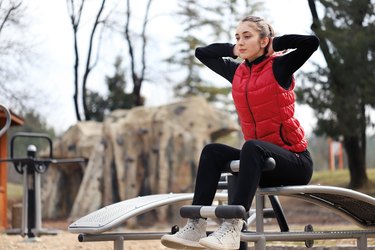
Your abdominal muscles support and enable movements of your trunk and spine. A pulled abdominal muscle refers to a tear in the muscle fibers, which can range from microscopic tearing to a complete rupture.
This type of injury, known as an abdominal muscle strain, usually occurs due to vigorous physical activity but can result from doing exercises, such as situps, incorrectly. There are several symptoms of a pulled abdominal muscles to watch for during or after doing situps, particularly if your core muscles are weak.
Video of the Day
Video of the Day
Lower Abdominal Muscles
Sudden pain in a specific area of your abdominal wall while performing situps might signal a pulled abdominal muscle.
The location of the pain corresponds to the site of the tear. For example, the pain might occur in your side if the tear occurs in one of the obliques, or you might have lower abdominal pain from situps if the strain involves the rectus abdominus. This type of immediate, sharp pain usually accompanies a moderate to severe strain, and might not occur with a mild abdominal muscle pull.
Other symptoms of a muscle strain can include redness or bruising, difficulty moving, swelling or muscle spasms, according to the Mayo Clinic.
Delayed and Ongoing Pain
In some cases, pain does not occur immediately but develops after pulling an abdominal muscle. This is particularly true with a mild abdominal muscle strain. Delayed or ongoing pain due to an abdominal strain can range from mild soreness to intense discomfort.
The area directly over the site of the tear is often tender when touched. A severe abdominal muscle strain can cause swelling and bruising at the site of the tear — although this is very rare with a tear caused by situps.
Lower abdominal pain after exercise is typically triggered or intensified when contracting your abs. This can occur with everyday activities, such as lifting grocery bags or sitting up from a reclining position.
Coughing, sneezing and deep breathing also typically worsen the pain. Trying to perform situps or other exercises that work your abdominal muscles will also provoke pain and might worsen the original injury.
Next Steps and Precautions
Most muscle strains that cause lower abdominal pain from situps are mild and heal on their own. Applying a cold compress to the area for the first 24 to 48 hours can help reduce your discomfort, according to the Mayo Clinic.
An over-the-counter pain medicine, such as acetaminophen (Tylenol) or ibuprofen (Advil, Motrin), might also be helpful, if approved by your doctor. Resting your injured abdominal muscle is the key to recovery. This entails avoiding any activity or exercise that relies of contraction of the injured muscle. Once your pain subsides, you can gradually begin to return to your usual activities.
In some cases, what seems to be an abdominal muscle strain might actually be a more serious problem, such as a hernia. See your doctor right away if you experience any warning signs or symptoms, including:
- abdominal or groin swelling or a bulge
- severe or worsening abdominal or groin pain
- nausea or vomiting
- fever or chills
Read more: Pulled Abdominal Muscle or a Hernia?
Is this an emergency? If you are experiencing serious medical symptoms, please see the National Library of Medicine’s list of signs you need emergency medical attention or call 911.